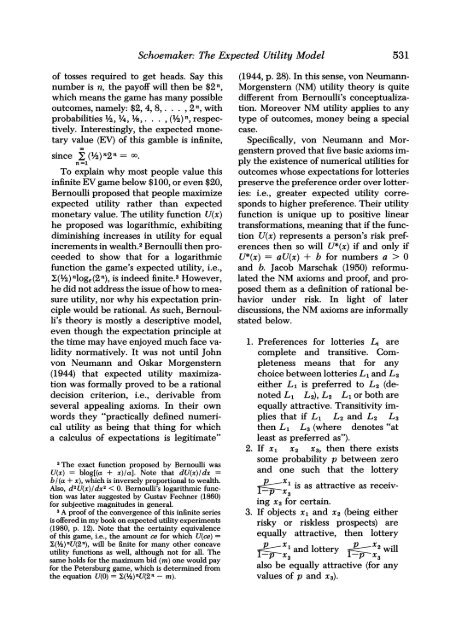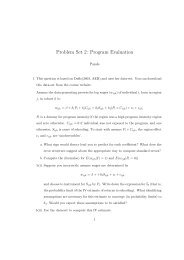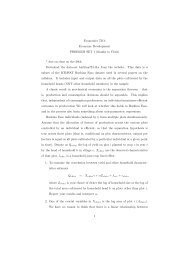The Expected Utility Model: Its Variants, Purposes, Evidence and ...
The Expected Utility Model: Its Variants, Purposes, Evidence and ...
The Expected Utility Model: Its Variants, Purposes, Evidence and ...
Create successful ePaper yourself
Turn your PDF publications into a flip-book with our unique Google optimized e-Paper software.
Schoemaker: <strong>The</strong> <strong>Expected</strong> <strong>Utility</strong> <strong>Model</strong> 531<br />
of tosses required to get heads. Say this<br />
number is n, the payoff will then be $2",<br />
which means the game has many possible<br />
outcomes, namely: $2, 4, 8, . . . ,2n, with<br />
probabilities Yz, %, %, . . . ,(Yz)n, respectively.<br />
Interestingly, the expected monetary<br />
value (EV) of this gamble is infinite,<br />
m<br />
since Z) ($5) n2n = m.<br />
n =l<br />
To explain why most people value this<br />
infinite EV game below $100, or even $20,<br />
Bernoulli proposed that people maximize<br />
expected utility rather than expected<br />
monetary value. <strong>The</strong> utility function U(x)<br />
he proposed was logarithmic, exhibiting<br />
diminishing increases in utility for equal<br />
increments in ~ealth.~ Bernoulli then proceeded<br />
to show that for a logarithmic<br />
function the game's expected utility, i.e.,<br />
B(Yz) nlog,(2n), is indeed finite.3 However,<br />
he did not address the issue of how to measure<br />
utility, nor why his expectation principle<br />
would be rational. As such, Bernoulli's<br />
theory is mostly a descriptive model,<br />
even though the expectation principle at<br />
the time may have enjoyed much face validity<br />
normatively. It was not until John<br />
von Neumann <strong>and</strong> Oskar Morgenstern<br />
(1944) that expected utility maximization<br />
was formally proved to be a rational<br />
decision criterion, i.e., derivable from<br />
several appealing axioms. In their own<br />
words they "practically defined numerical<br />
utility as being that thing for which<br />
a calculus of expectations is legitimate"<br />
<strong>The</strong> exact function proposed by Bernoulli was<br />
U(x) = blog[(a + x)la]. Note that dU(x)ldx =<br />
bl(a+ x), which is inversely proportional to wealth.<br />
Also, d2U(x)ldxZ < 0. Bernoulli's logarithmic function<br />
was later suggested by Gustav Fechner (1860)<br />
for subjective magnitudes in general.<br />
A proof of the convergence of this infinite series<br />
is offered in my book on expected utility experiments<br />
(1980, p. 12). Note that the certainty equivalence<br />
of this game, i.e., the amount ce for which U(ce)=<br />
H(h)"U(2"),will be finite for many other concave<br />
utility functions as well, although not for all. <strong>The</strong><br />
same holds for the maximum bid (m)one would pay<br />
for the Petersburg game, which is determined from<br />
the equation U(0)= H(%)nU(2n- m).<br />
(1944, p. 28). In this sense, von Neumann-<br />
Morgenstern (NM) utility theory is quite<br />
different from Bernoulli's conceptualization.<br />
Moreover NM utility applies to any<br />
type of outcomes, money being a special<br />
case.<br />
Specifically, von Neumann <strong>and</strong> Morgenstern<br />
proved that five basic axioms imply<br />
the existence of numerical utilities for<br />
outcomes whose expectations for lotteries<br />
preserve the preference order over lotteries:<br />
i.e., greater expected utility corresponds<br />
to higher preference. <strong>The</strong>ir utility<br />
function is unique up to positive linear<br />
transformations, meaning that if the function<br />
U(x) represents a person's risk preferences<br />
then so will U*(x) if <strong>and</strong> only if<br />
U*(x) = aU(x) + b for numbers a > 0<br />
<strong>and</strong> b. Jacob Marschak (1950) reformulated<br />
the NM axioms <strong>and</strong> proof, <strong>and</strong> proposed<br />
them as a definition of rational behavior<br />
under risk. In light of later<br />
discussions, the NM axioms are informally<br />
stated below.<br />
1. Preferences for lotteries L, are <br />
complete <strong>and</strong> transitive. Com-<br />
pleteness means that for any <br />
choice between lotteries L1 <strong>and</strong> L2 <br />
either L1 is preferred to L2 (de- <br />
noted L1 L2), L2 Ll or both are <br />
equally attractive. Transitivity im- <br />
plies that if L1 L2 <strong>and</strong> L2 L3 <br />
then L1 L3 (where denotes "at <br />
least as preferred as"). <br />
2. If xl x2 x3, then there exists <br />
some probability p between zero <br />
<strong>and</strong> one such that the lottery<br />
&:: is as attractive as receiv- <br />
ing x2 for certain.<br />
3. If objects xl <strong>and</strong> x2 (being either <br />
risky or riskless prospects) are <br />
equally attractive, then lottery<br />
eX1eX2<br />
<strong>and</strong> lottery will<br />
P x3 1-P x3 <br />
also be equally attractive (for any <br />
values of p <strong>and</strong> x3).




